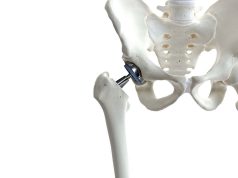No clinically or statistically significant difference seen in mean change in Manchester-Oxford Foot Questionnaire walking/standing domain scores
By Elana Gotkine HealthDay Reporter
TUESDAY, Nov. 15, 2022 (HealthDay News) — For patients with end-stage ankle osteoarthritis, total ankle replacement (TAR) and ankle fusion (AF) have similar clinical scores and harms, according to a study published online Nov. 15 in the Annals of Internal Medicine.
Andrew J. Goldberg, M.B.B.S., from the UCL Institute of Orthopaedics & Musculoskeletal Science in London, and colleagues conducted a randomized trial to compare TAR to AF among patients with end-stage ankle osteoarthritis, aged 50 to 85 years. The primary outcome was change in Manchester-Oxford Foot Questionnaire walking/standing (MOXFQ-W/S) domain scores from baseline to 52 weeks after surgery.
Three hundred three patients were randomly assigned between March 6, 2015, and Jan. 10, 2019; clinical scores were analyzed for 281 participants. The researchers found that at 52 weeks, both groups had improvement in the mean MOXFQ-W/S scores. The adjusted difference in the change in MOXFQ-W/S score was −5.6 from baseline, with more improvement seen for TAR than AF; the difference was not clinically or statistically significant. A similar number of adverse events occurred between the groups (109 versus 104); more wound healing issues occurred in the TAR group, while the AF group had more thromboembolic events and nonunion. For AF, the symptomatic nonunion rate was 7 percent. In a post hoc analysis, the superiority of fixed-bearing TAR over AF was suggested (−11.1).
“Both TAR and AF improve patients’ MOXFQ-W/S scores at 52 weeks, but overall, neither procedure is superior in terms of clinical scores,” the authors write.
Editorial (subscription or payment may be required)
Copyright © 2022 HealthDay. All rights reserved.








